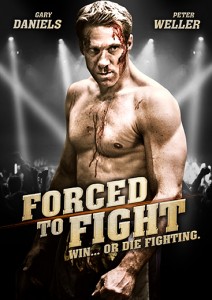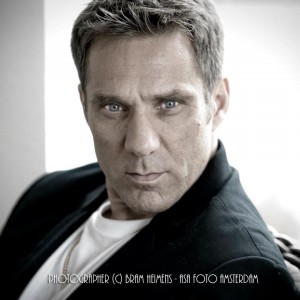After an accomplished kickboxing and karate career, Gary Daniels made the transition into acting in the late 80s. Since then, Daniels has been the lead in numerous B movies and performed alongside better-known action stars like Jackie Chan, Dolph Lundgren and “Stone Cold” Steve Austin. Daniels biggest mainstream exposure came in 2010 when he was part of the ensemble cast of Sylvester Stallone‘s The Expendables. But with the Dec. 18 release of Forced to Fight, Daniels gets the leading role again alongside the original RoboCop, Peter Weller (playing a crime lord villainously similar to the corrupt cop he played on Dexter). In the film, Daniels plays a retired fighter who has no choice but to get back into the underground fight scene in order to pay of his brother’s debt. With Forced to Fight now available in DVD, Blu-ray and digital download, Daniels talks to Wrestling with Pop Culture about making this film and his career goals going forward.
You made the transition from kickboxing to acting many years ago…
I attempted to. I’m still working on that.
But with Forced to Fight you’re also the fight choreographer. Have you been a fight choreographer on many of your previous films?
 I’ve actually choreographed a lot of fights in a lot of the films that I’ve done. It’s something I like to do, but unfortunately to really get your vision for a fight scene on film not only do you have to choreograph it, you have to direct it, choose the right lenses for the camera, get the right camera angles and get into the editing room to edit the fight. I choreograph the fights, but I don’t get a say on the direction or in the editing room. So very rarely do I ever get my vision.
I’ve actually choreographed a lot of fights in a lot of the films that I’ve done. It’s something I like to do, but unfortunately to really get your vision for a fight scene on film not only do you have to choreograph it, you have to direct it, choose the right lenses for the camera, get the right camera angles and get into the editing room to edit the fight. I choreograph the fights, but I don’t get a say on the direction or in the editing room. So very rarely do I ever get my vision.
How close would you say the fight scenes in Forced to Fight came to what you had envisioned them to be?
The problem with Forced to Fight was I wasn’t the original choreographer. Before I went to Romania to shoot the film, I asked if they already had a fight choreographer and they told me they had a local guy in Romania doing it. So when I went out there I hadn’t done any prep for any kind of fight scenes, I hadn’t done any prep on who I’d be fighting. That’s what you normally do is you prep the fights in advance before you actually get to the set. But once I got to Romania, about two or three days before the actual shooting, I looked at what the local choreographer had done and it was very substandard to what I was expecting, and what I expect of myself. So I had to re-choreograph, from scratch, all of the fights and I only had a couple of days. There’s, like, 15 fights in that film and each of them has to have a story in regards to where they fit in the film and where the characters are at emotionally in the film. Another problem was that the guys I had to fight were not film fighters. These guys were real kickboxers, real wrestlers, a couple of gangsters. One guy was 6’9″ – lovely fellow – and this guy had bullet wounds all up his arm because he had been in a shoot-out with the police when his brother was being killed. These are the kind of guys they brought me to fight. So not only was I trying to choreograph the fights, I was trying to teach these guys how to movie fight. It was a very difficult challenge.
So when you ask me how much of my vision did I actually get, if I had been working with real film fighters it would have been a lot better. When you do a film fight, it’s like doing a dance with a partner – you have to work in tandem with each other. One gives, one takes, one pushes, the other one pulls, you give each other the right distance. So when you work with proper movie fighters and stuntmen, they understand this. But when you’re working with real fighters, it’s a difficult concept for them because they’re used to winning and disrupting rhythm. In a real fight you’d disrupt your opponents rhythm, not work with it. I’m not going to say it’s the best fights I’ve done, but I think with the time we had and what we had to work with we did a pretty good job. If I had to give you a percentage, I’d say it would be maybe 40-50 percent of what I’d have like to have seen.
In many of your films, your character is based largely on your interaction with the bigger stars of each film like Jackie Chan, “Stone Cold” Steve Austin or, in this case, Peter Weller. How would you say working with Weller compared to some of the other actors and action stars you’ve worked with?
When you’re working with someone that’s the caliber of actor that Peter Weller is, it only elevates your own performance. Peter is a fantastic actor and he brought so much to the character he played in Forced to Fight that it was an absolute pleasure working with him. I know it helped elevate my character and my performance in the film. I’ve done about 60 films and early in my career, in about two-thirds of my films, I was the lead actor. What they’d do is bring in bigger name actors to support me for the sales. Sometimes you find that some of these bigger actors come onto these smaller films and just do it for a paycheck. It looks like they’re sleepwalking through the roles. But I have to say that with Peter, he truly brought it. He did a perfect performance in the film and it was an absolute pleasure working with him. You’re always apprehensive when you have these bigger name guys coming off these huge productions, and sometimes they show some apprehension coming to the set. But after the very first scene I did with Peter, I stepped out of the car where we were shooting and went straight to the director and said, “Well, I think we’e got something here.” He had a great presence and brought so much to the character.
You’ve worked with numerous big names, especially in The Expendables. Are there any particular action stars or bigger names you have yet to work with that you’d like to?
 To be honest with you, I’m not really looking to work with certain action stars. I’d really like to work with some of the actors like Leonardo DiCaprio and some of the other bigger actors. It’s not working with these actors that’s going to help promote my career. It’s really just trying to work with a higher level of production with better writers and better directors. I’d love to work with Ridley Scott, Christopher Nolan and some of these bigger directors. That’s what’s really going to help take my career up another notch. Just working with these B movie action guys like myself is not going to elevate my career. Having done 60 of these films, I’m probably closer to that level. But I really want to work with good writers, good directors, better actors. Like every other actor, I want to step it up a notch and move up another level. So I’m going to be looking for that break and I’m not going to do it by doing another Steve Austin movie. Nothing against Steve, I love the guy to death.
To be honest with you, I’m not really looking to work with certain action stars. I’d really like to work with some of the actors like Leonardo DiCaprio and some of the other bigger actors. It’s not working with these actors that’s going to help promote my career. It’s really just trying to work with a higher level of production with better writers and better directors. I’d love to work with Ridley Scott, Christopher Nolan and some of these bigger directors. That’s what’s really going to help take my career up another notch. Just working with these B movie action guys like myself is not going to elevate my career. Having done 60 of these films, I’m probably closer to that level. But I really want to work with good writers, good directors, better actors. Like every other actor, I want to step it up a notch and move up another level. So I’m going to be looking for that break and I’m not going to do it by doing another Steve Austin movie. Nothing against Steve, I love the guy to death.
Forced to Fight is out today, but it looks like you have a few other films coming out soon.
One of the films I’m proud of is something I worked on last year in Thailand called Angels. The lead was Dustin Nguyen, who was the Vietnamese character on the original 21 Jump Street, and he’s a very good actor. We had a brilliant, fantastic script, but it was on a budget. We just had the world premiere screening in Vietnam and they took me over for the premiere. I was very, very happy with the way the film turned out. The director was a guy named Wych Kaos – he wrote it, directed it and produced it – and he’s a genuinely talented filmmaker. That should be coming out sometime next year and I think it could do some great things for me. It was a straight acting role for me without any fighting. I was happy with the performance in the film overall, so I’m looking forward to that coming out.
Any chance you might currently be working on something that might take you to that next level as an actor?
I do have a few projects in the works, but not the kind of projects I’m looking for right now. I have three or four projects in the works for next year, but I’m still looking for that one break-out role. It’s pretty difficult when you come from a fighting or sports background. When you do make the transition into the film industry, it’s very hard to get people to take you seriously as an actor. When you come from a fighting background, you’ve learned to not show any emotions. So if you’re tired or hurt, you can’t show it. But in the movie industry, as an actor, you have to wear your emotions on your sleeve so everyone in the audience can see it and feel what you’re feeling. One of my early acting coaches would say, “Look, Gary. I know you’re feeling it but we have to see that you’re feeling it.” I have been working very hard on my acting and the only way you’re going to move up is not by being a good martial artist, it’s going to be by being a good actor.
